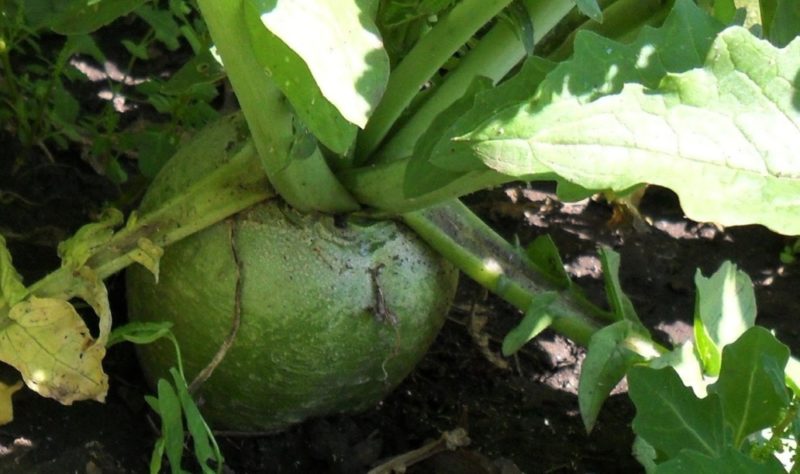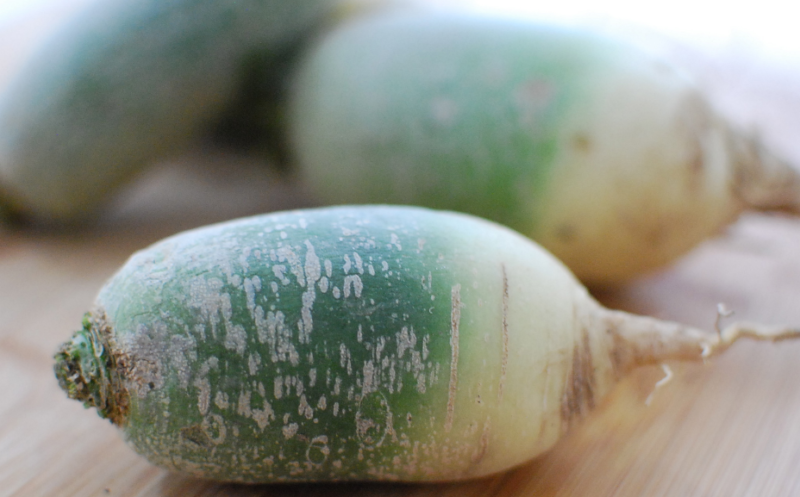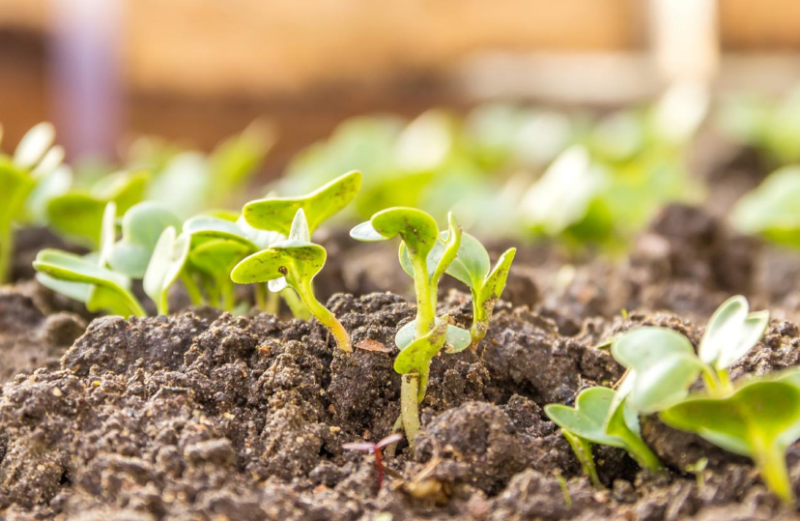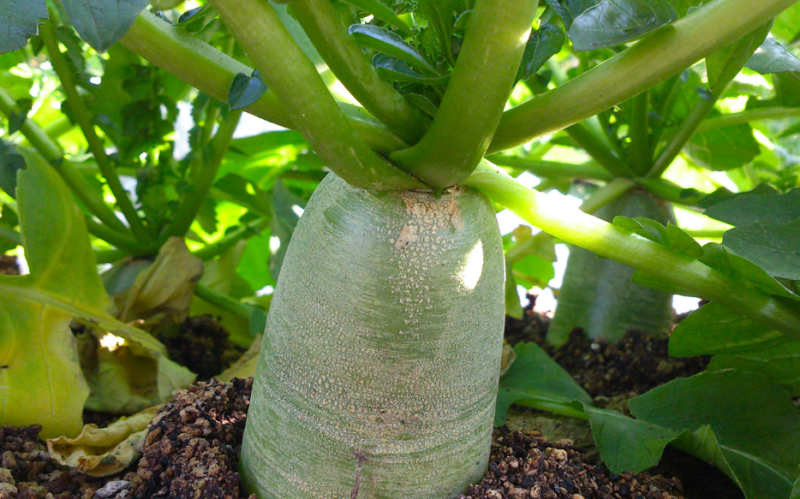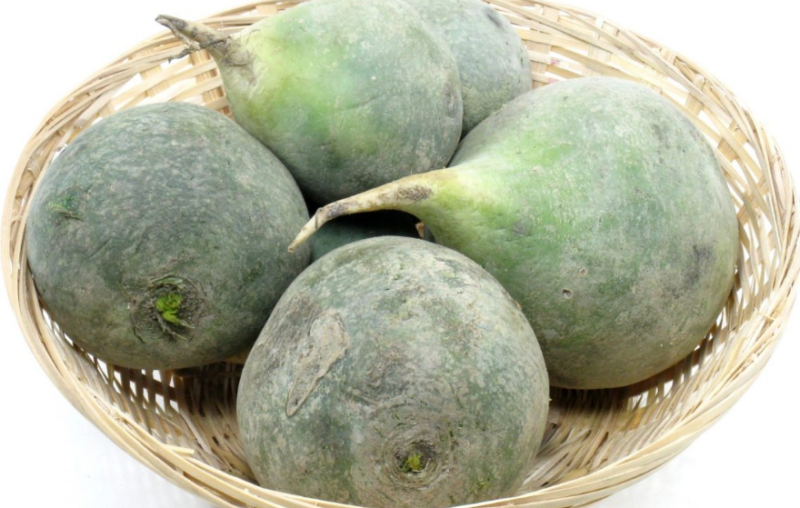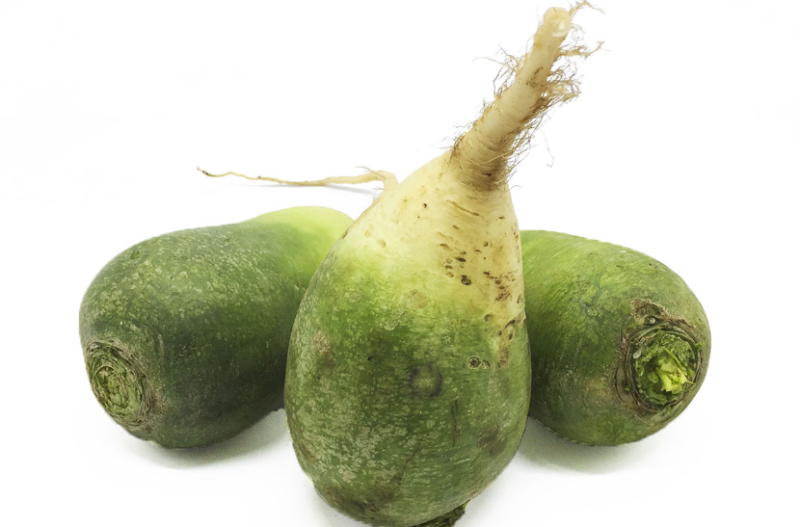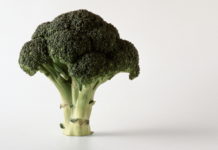Among many root crops known to man, green radish stands out. This culture, out of habit, can be mistaken for a strange plant; its shape and shade are so unusual. What is the difference between this radish and its “fellow” cabbage, and how to grow it properly?
Material Content:
Characteristics and features of green radish
Green radish also has an alternative name - Margelan, which it received by the name of the settlement Margilan in Uzbekistan. Initially, this root crop was transported from China along the Silk Road, and that, in turn, ran through this city.
It is interesting. In addition to Margelan, green radish is also called “forehead” or “Chinese”.
Detailed view of the view:
- Margelan radish belongs to the cabbage family, as, in fact, the rest of the radish.
- Uninitiated people are often puzzled by her appearance. So, a green radish can be round or elongated, and its color can be white, saturated green, purple, pink and red. Chinese radish has white, pink or greenish flesh. The taste of root vegetables is devoid of bitterness, pleasant, crispy.
- A distinctive feature of the culture is a greenish tint in the area near the tops.
- The root crop is considered mature in 2 - 3 months. At the time of harvest, the radish acquires a light green color. It can weigh up to 1 kg, but on average - 300 - 500 g.
- By the number of vitamins, green radish is inferior to its "brothers", but in terms of mineral content it is a recognized record holder. It contains excess manganese, as well as iron and magnesium.
In Japan, such a radish is considered the leading garden crop. On average, its productivity is 300 - 500 centners per 1 ha.
Advantages and disadvantages of the variety
The vegetable culture under discussion has a number of advantages and disadvantages, from the point of view of physicians, gourmets and gardeners. Let's consider some of them.
Pros:
- Softer, in comparison with ordinary radish, taste. Lack of sharpness.
- An impressive amount of minerals.
- Unpretentiousness in leaving.
- Easy to transport and store.
- Resistance to frost.
- It can bear fruit twice a season.
Minuses:
- Inadequate watering can make Margelan radish bitter and tough.
- The root crop is susceptible to damage by insects and fungal infections.
An additional advantage of green radish is its obvious benefit to the human body.
Useful properties for the human body
The rich mineral composition of Margelan root crop makes it an excellent help in solving multiple health problems.
The following beneficial properties of green radish are distinguished:
- Anti-inflammatory. The root crop helps eliminate the symptoms of flu and bronchitis.
- Choleretic. Daily use of radish helps to remove excess cholesterol from the body.
- Bactericidal. A vegetable helps strengthen immunity.
- The ability to restore intestinal microflora. The beneficial substances in the composition of the radish help eliminate dysbiosis and other digestive system problems, in particular, constipation.
- Vitamin B5 in the composition of the root helps to normalize blood pressure.
Margelan radish is also useful from the point of view of cosmetology. The problem of dull, brittle and falling hair can be solved by rubbing root juice into the scalp.
Outdoor landing
Growing from the seeds of green radish is appropriate to start with sorting of planting material. It is necessary to choose the most even and large seeds, soak them in water, adding a growth stimulator. You can take the drug "Epin" in the amount of 2 drops and add it to 100 ml of water. Seeds are soaked in this solution for 4 hours.
Seating should be located in the sunlit territory. Since the radish is a root crop, it is impossible to plant it in the ground where root crops previously grew. It is permissible to plant a green culture after onions, cucumbers, tomatoes. The forehead is not very whimsical in relation to the soil, but grows best on neutral soils.
It is better to start growing green radish in open ground when the air temperature reaches at least 18 ° C.
- On the bed should be marked grooves 30 cm from each other.
- The soil is watered, and after absorbing moisture, 2 to 3 pcs are planted. seed per well 2 cm deep.
- The distance between the holes should be approximately 15 cm.
- The seeded material is sprinkled with soil and mulched with peat.
Tip. For quick emergence of radish, it can be covered with a film, which is removed after the seeds break through.
Cultivation and care
- Thinning shoots of green radish is carried out when 2 to 3 leaves break through the soil. In the holes should be left 1 sprout, the strongest.
- Water the plant should be plentiful and regular, otherwise the root crop will be bitter. In matters of watering, the amount of precipitation should be taken into account. The approximate number of watering the beds is once a week. In areas with arid climates - twice a week. It is necessary to monitor the uniformity of irrigation, based on the calculation of 10l / m2. The volume of water should not be changed - root crops from this can crack.
- Margelan radish should be spud and loosen. Softening the soil is necessary for free access of air to the roots. When the top of the root grows 2 cm above the ground, the plant is spud.
- It is also necessary to timely remove tops and weeds that interfere with the development of root crops and can become a breeding ground for pests. Withered leaves and tops, creating excessive shadow, are removed. Weed control should be carried out systematically, combining this process with cultivation.
- Fertilize the bed for the first time should be in the fall. For fertilizer, compost / manure is used at the rate of 6 kg / m². In spring and summer, 2 top dressings are carried out, while fertilizers should not be organic (radish can start flower stalks). As the first 3 to 5 leaves appear, they make nitrogen fertilizers that contribute to the active development of the radish. By the end of the first month, the root phase begins in active growth. A second top dressing should be performed, diluting potassium (15 g), phosphorus (60 g) and urea (20 g) in 10 l of water. The indicated volume is enough for one bed.
Protection against diseases and pests
Significant harm to green radish can be caused by the following diseases: powdery mildew, black leg, gray rot. For the purpose of prevention, weeds should be weeded in a timely manner and dry leaves should be removed. Infected plants should be treated with chemicals: vitriol, Bordeaux fluid, etc.
Sometimes a mosaic can hit a radish. There is no therapy against this disease, the diseased plant should be removed from the garden.
As for insects, the main enemies of the radish are cabbage flies, black fleas, slugs. The occurrence of the latter can be prevented by hilling the tops of root crops. You can prevent the attack of other pests by dusting the beds with tobacco ash and ash. If preventive measures did not help, and the insects wound up, the root crop should be treated with insecticides, for example, Aktara, Imidilit.
Harvesting and storage
Margelan radish harvest time depends on the variety. It is important to note the number of days from sowing to ripening. So, Chinese radish can be early, late, as well as summer, winter and autumn.
- Summer varieties are harvested in early June. Such root crops are not stored for long.
- Autumn varieties must be harvested before the end of summer.
- Winter radish is harvested before the first frost.
Cleaning is carried out in dry weather, morning or evening, when the sun has not reached a peak in its activity.
When the soil is light and the fruits are small, they are pulled out, holding the tops at the base. Large and heavy root crops that grow in heavy soil are best removed with a shovel.
Store Margelan radish until spring. Only healthy specimens should be laid for storage without cracks and cuts. In this case, the tops are cut off, leaving only 2 - 3 cm. Store the culture in sand-filled containers at a temperature of 1 - 2 ° C and a humidity of 90%.
Contraindications to the use of vegetables
Despite many advantages, green radish is not suitable for everyone.
The root crop is contraindicated in the following cases:
- stomach diseases in the acute stage;
- tendency to allergy to radish;
- pathology of the liver and kidneys, pancreas;
- increased acidity of the stomach;
- propensity for gas formation.
Tip. Do not give green radish to children under 5 years of age. Pregnant women should consult a doctor before eating this root vegetable. Radish can cause uterine tone, which, in turn, can cause a miscarriage.
Green radish is a tasty and healthy root crop used by a person in the field of cosmetology, medicine and cooking. It is not surprising that many want to feast on this original fruit grown on their own beds. The process of planting radish, caring for it and further storage requires compliance with a number of rules, however, not too complicated and feasible for everyone.


